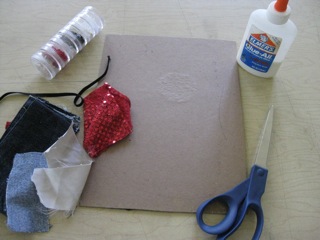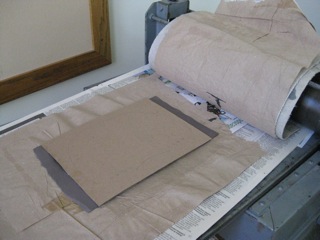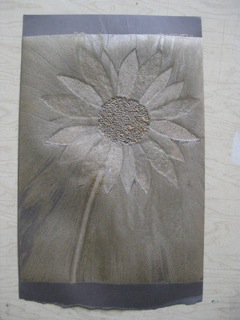

Printmaking Article |
How to Make a Collagraph Print By Rachel Edwards Collagraph is simply making a print of a collage.1 This process is relatively simple and can be enjoyed by virtually every age group.1 Collagraph printing is an inexpensive technique.4 This process is often simplistic and repetitive, thus challenging the artist’s creativity by making him or her think outside the box when selecting materials.4 Color and texture are key in making an effective print.4 |
|---|
| Step 1: Topic |
The initial design of a print is very important, because great art does not simply happen. Therefore, brainstorm different ideas is crucial in making a print.1 Your first idea is probably not going to be your best idea, instead the fourth or fifth idea probably will be. Talking with fellow artists and get their feed back on your ideas is also a good starting point to coming up with a brilliant idea. |
| Step 2: Materials |
 Once you have an idea you can begin gathering materials that will create your print. You will need to make a plate; a stiff piece of cardboard will work. Masonite, matboard, or thin metal are other options.4 Also, a 4-6mm piece of thin wood can be used as a plate.2 Liquid glue or hot glue can be used to attach materials to the plate.5 Stationary weight or card stock work best for printing on, and the color is a preferance.5 Printing ink, acrylic, or water based paint are the most common paint options. Other materials you may want are: newspaper, scissors, paper towel, and a paintbrush. Lastly you will need a printing press. If you do not have a printing press a brayer or rolling pin will work, however, the press works best.5 Once you have an idea you can begin gathering materials that will create your print. You will need to make a plate; a stiff piece of cardboard will work. Masonite, matboard, or thin metal are other options.4 Also, a 4-6mm piece of thin wood can be used as a plate.2 Liquid glue or hot glue can be used to attach materials to the plate.5 Stationary weight or card stock work best for printing on, and the color is a preferance.5 Printing ink, acrylic, or water based paint are the most common paint options. Other materials you may want are: newspaper, scissors, paper towel, and a paintbrush. Lastly you will need a printing press. If you do not have a printing press a brayer or rolling pin will work, however, the press works best.5The materials put on the plate are up to the artist. However, keep in mind that the materials should not be too thick (can tear the paper) or have sharp edges (can ruin the press).2 Almost any material will work as long as it is no higher then 1/8 inch.5 Some ideas to get you started are: fabric, lace, rope, leaves, rice and other house hold items. Remember, the more variety of texture on your plate the better it will turn out.2 |
| Step 3: Preparing the Plate |
Cut the plate to the size you want your print to be.5 If you are using a rolling pin or brayer the process will be difficult if it is bigger then 10”x10”.5 If a press is being used then the plate can be as large as the press can handle.5 |
| Step 4: Layout the Design and Gluing |
|
| Step 5: Inking the Plate |
|
| Step 6: The Press |
 If you are using a press: the press is the best method, but be sure to do a test print to make sure the pressure is adjusted correctly.5 The press should have two pieces of felt, which should be the outer layers of this “sandwich”. Next to the felts should be plain news print (to keep felts clean) and between those should be your damp paper with your plate on top.3 If you did not want to use news print, newspaper touching the felt and paper towel directly on top of and under the damp paper and plate (the paper towel is used to keep words and images from the news papers off your paper). The press is the best method, but be sure to do a test print to make sure the pressure is adjusted correctly.5 If you are using a press: the press is the best method, but be sure to do a test print to make sure the pressure is adjusted correctly.5 The press should have two pieces of felt, which should be the outer layers of this “sandwich”. Next to the felts should be plain news print (to keep felts clean) and between those should be your damp paper with your plate on top.3 If you did not want to use news print, newspaper touching the felt and paper towel directly on top of and under the damp paper and plate (the paper towel is used to keep words and images from the news papers off your paper). The press is the best method, but be sure to do a test print to make sure the pressure is adjusted correctly.5If you are using a rolling pin or brayer: be sure to apply even pressure and only make a few passes (the more passes you make the more likely the plate will move and cause a blurry print).5 |
| Step 7: Drying and Trimming |
 Allow the print time to dry out thoroughly, a drying rack is preferable, however a table where it will not be touched will work.5 When the paper is completely dry trim the edges to the desired size.5 Allow the print time to dry out thoroughly, a drying rack is preferable, however a table where it will not be touched will work.5 When the paper is completely dry trim the edges to the desired size.5 |
| References |
1 Basso, Robert. "Collagraphy." Arts & Activities 118.3 (1995): 16. |